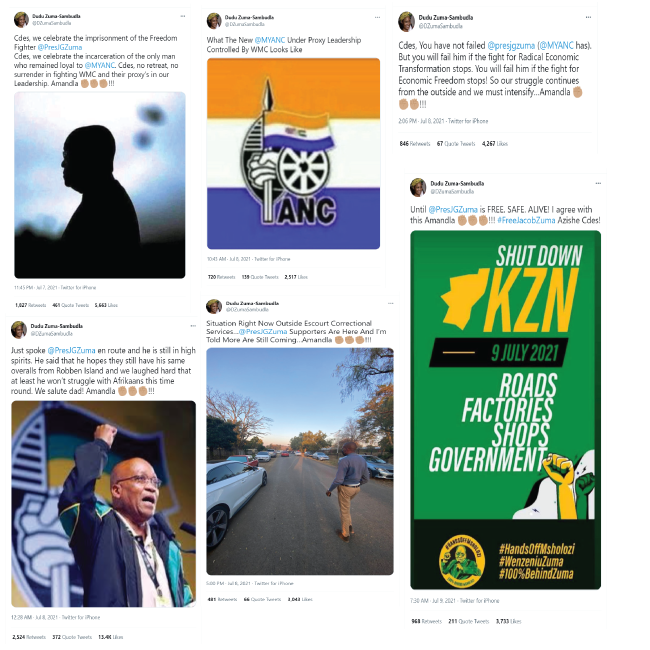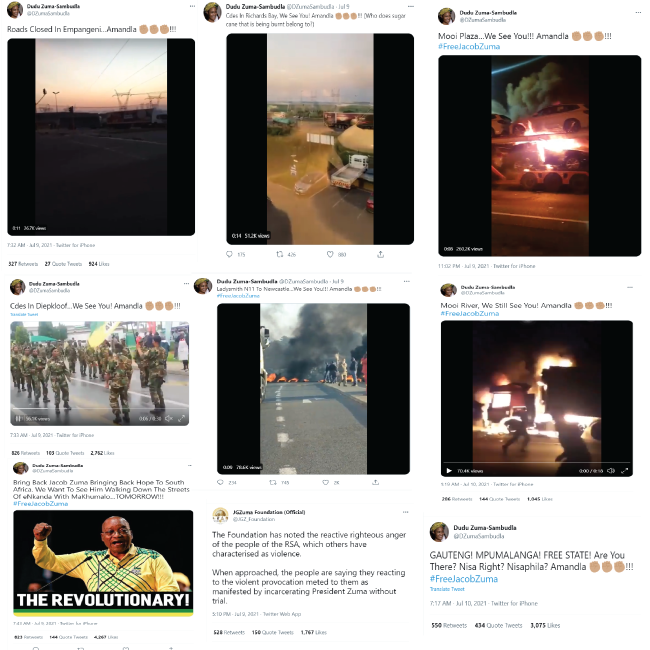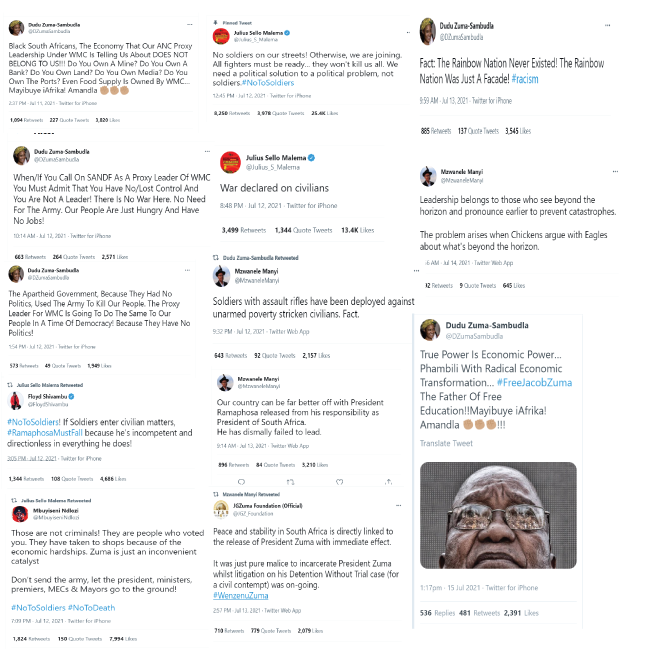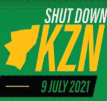What did (Dr) Hannibal Lecter say to Clarice Starling? “First principles, Clarice. Read Marcus Aurelius. Of each particular thing ask: what is it in itself? What is its nature?”
To help with our first principles, let us ask four questions. What happened? Who was behind it? What was the purpose? And where to from here?
Massive waves of looting and arson began on the evening of Friday, 9 July in KZN, six days ago, and spread to Gauteng on Sunday, 11 July.
A still unspecified number of trucks, though it’s said to be 35, were set alight on the N3 highway between Joey’s and Durban. Public violence, burglary, malicious damage to property, widespread looting, and arson were reported in parts of Durban and Pietermaritzburg (PMB), with at least 28 people being arrested.
The unrest continued on the evening of Sunday (11 July), when multiple news sources reported gunshots and explosions at local malls and residential areas, mainly in Durban. The violence escalated, and by Monday morning, many companies and malls were forced to close. As of 13 July (Tuesday), 72 people had died due to the unrest and about 1 500 have been arrested.
From what one can tell, all the shopping malls in PMB, many of the malls in Durban’s less affluent areas, and a number in Soweto, had been looted and badly wrecked. In Durban, food storage and other warehouses were also attacked and looted. Finally, a number of vaccination sites, especially in Durban, had to be shut down – in the middle of a pandemic.
According to various newspapers, 200 shopping centres were looted and/or ransacked and yesterday the SA Pharmacy Council noted that 90 pharmacies were completely destroyed, the KZN ones being the hardest hit.
Additionally, a number of Durban (and some Soweto and other) “communities” organised themselves into self-defence (or “vigilante,” depending on your point-of-view) units, which could have exacerbated what we Seffricans politely call “inter-ethnic tensions”. [i]
Obviously, there are, and are going to be, unpleasant effects. Container ports at Richards Bay and Durban have ceased operations for the nonce. Containers in the port of Durban port have apparently been plundered. The N3 highway is not yet fully open.
Shell & BP SA Petroleum Refineries have ceased operation for the moment, as have many logistics companies. There are likely going to be fuel, gas, food (especially fresh produce) and medicine shortages in KZN and Gauteng. The Rand weakened 2% on July 12.
Based on a preliminary analysis on 13 July, the SA Special Risks Insurance Association estimated that total losses due to damage and looting could come in at “billions of rand”. The mayor of eThekwini announced that up to 45 000 businesses were affected, 129 000 jobs were at stake, and he calculated that more than R16 billion in damages to stock, property, and equipment had been caused.
As a result, the government had by yesterday shaken itself out of its torpor – and police people were to be seen (often for the first time) in Durban and its environs and in other places; and a little begrudgingly (initially), Minister of Defence Nosiviwe Mapisa-Nqakula agreed to deploy 25 000 troops (versus the 2 500 deployed a week ago).
But readers probably know most of the above. What everyone wants to know is whether or how much all this had to do with former president Jacob Zuma (are these the “Zuma riots”)? Or is he, his court shenanigans, and his imprisonment “just by the way”? I.e., we all want to know the who (besides the hundreds of foot soldiers/looters), the why and the what for?
As for the “who” it is as obvious as the nose on one’s face. In 2008 Zuma’s supporters – including Julius Malema and others – made blood curdling threats of mass violence and disruption if the newly elected ANC President’s trial went ahead. This successfully spooked much of the media, and eventually the National Prosecuting Authority as well, which unlawfully dropped the charges. But as Politicsweb for one noted at the time, “If Zuma had any love for the rule of law he would not have tolerated the attacks by his subordinates on the judiciary or the threats of violent disruption and murder made on his behalf. Instead, he has allowed certain creatures within the ANC to go ahead and prepare to tear our constitutional state apart, limb from limb, in order to clear his path to power. This, far more than the corruption allegations themselves, is what proves his unworthiness for the highest office.”
Zuma is a much older leopard by now, but he has not changed his spots. His allies have long been issuing dire threats that everyone would be bitterly sorry if Zuma were imprisoned. We further know this violence was launched on his behalf, and with his approval, as it was own daughter – who is in close contact with her father - who took the lead role in publicly inciting it. The following image contains a number of the Tweets of Duduzile Zuma on the day of her father’s incarceration and immediately after. These call for no retreat and no surrender in the fight against an ANC leadership allegedly controlled by WMC. On the early morning of the 9th July 2021 she distributed an image of a leaflet titled “Shut Down KZN” calling for the targeting of roads, factories, shops and government.

As the violence spread across the province that day she posted video images of the violence being inflicted by pro-Zuma comrades with fist emojis, each saying “we see you” and “Amandla!”. At 5 pm that day the Jacob Zuma Foundation put out a Tweet stating that it had “noted the reactive righteous anger of the people of the RSA, which others have characterised as violence. When approached, the people are saying they reacting to the violent provocation meted to them as manifested by incarcerating President Zuma without trial.”

Who was it though who did the hard and dirty work? Yesterday, the Daily Maverick’s Ferial Haffajee wrote that much of it was allegedly organised, on the ground level, by pro-Zuma ANC structures and former-MK-member networks in KwaZulu Natal and Gauteng, using messaging tools like Telegram and WhatsApp.
“Twelve masterminds planned and executed insurrection on social media, then lost control after looting spree,” and (as have other journalists) she mentions the names of former special ops boss at the SSA (state security agency), Thulani “Silence” Dlomo, and other MKMVA members; she shows some of the incendiary SMSs; and she writes that starting with “the N3 campaign, the plan was to attack symbols of ‘White Monopoly Capital’, which explains the looting of warehouses and more than 200 malls,” adding that “specific chains were targeted”. It has been reliably reported that, in line with the "Shutdown KZN" list, electric substations and water purification plants and reservoirs have also been targeted.
Let’s also not forget that the proverbial tinder to which the match was set is right there and it’s not getting drier or disappearing. There’re a lot of frustrated and hungry (even starving) people just down the road – and the pandemic restrictions and controls have not made anyone less frustrated or hungry. You can quickly raise an army of thousands if you promise them easy loot.
Julius Malema seems to be trying to choose the right moment to join the insurrection. He first threatened that were Ramaphosa to deploy the SANDF “we are joining. All fighters must be ready”. He has not yet unleashed the red berets however, perhaps because this is an inadequate causus belli for EFF supporters, given that they are mostly highly anti-Zuma.
What then was the purpose (the “what for”) of this highly economically destructive violence unleashed upon the economy of Zuma’s own home province? It seems likely that the planning for something like this had been in the works for a long time, perhaps going back to early 2017, and that Zuma’s imprisonment was merely the pretext for launching it.
The goal appears to make Ramaphosa look weak and not in charge (something not hard to do), to then force him out of office through some kind of internal party coup d'état, and thereby bring the RET faction and EFF back into power, while bringing the national revolution to completion (by seizing the wealth of the whites).
In terms of the training Zuma and other MK members received in exile the essential goal is to establish the “Leninist preconditions for a revolution: first, a government that no longer commanded the confidence of the people, and second, a government that had lost faith in its ability to solve its problems as growing lawlessness, misery and violence overwhelmed it.”
The difference in this case is that the fight is largely within the ruling liberation movement and the state structures it dominates. Declaring a state of emergency in such circumstances would be a highly dangerous thing to do, as the threat to the Constitutional order comes in part from within the security services, which are still riddled with RET elements placed there by Zuma.
The next question is where to from here?
The mayhem and destruction of the last week have shown (or reminded us) that Zuma and his supporters are quite capable of anything. He might be charming, a good dancer, and kind to Helen Zille, but he has an evil nature, and there is no wickedness beyond him or those around him.
From the various Twitter feeds of the insurrectionists, it is clear that the objective now is to further engineer racial collisions between black and non-black. Any reaction or over-reaction by minority communities to having their areas looted and trashed by violent mobs is being used to try and further inflame inter-racial hatred. If this is done successfully enough then Malema will have his pretext for bringing the Fighters into the fray.
Though some calm may have returned for the moment Ramaphosa, and the country, remain in a highly perilous place.
Endnote:
[1] Some points about these units. First, given that the police were for the most part not to be seen for the first four days or so, and were by their own admission outpersonned and under- or incorrectly armed (apparently the quartermaster omitted to keep up deliveries of rubber bullets), these units, including private security company personnel, were initially welcomed by the police.
Second, these community groups looked pretty well-armed; so much for Minister of Police Bheki Cele’s desire to see “in the future a South Africa where only law enforcement officers will carry firearms”; dream on, Minister. Third, some of the Durban units clearly had members from all “ethnicities”.
Fourth – a more general point – the Johannesburg “northern suburbs,” nearly all other Johannesburg suburbs (as opposed to, say, Daveyton, near Benoni), were quiet as mice, other than for the din of anxious folk doing panic-buying in supermarkets and causing mini-super-spreader events.


